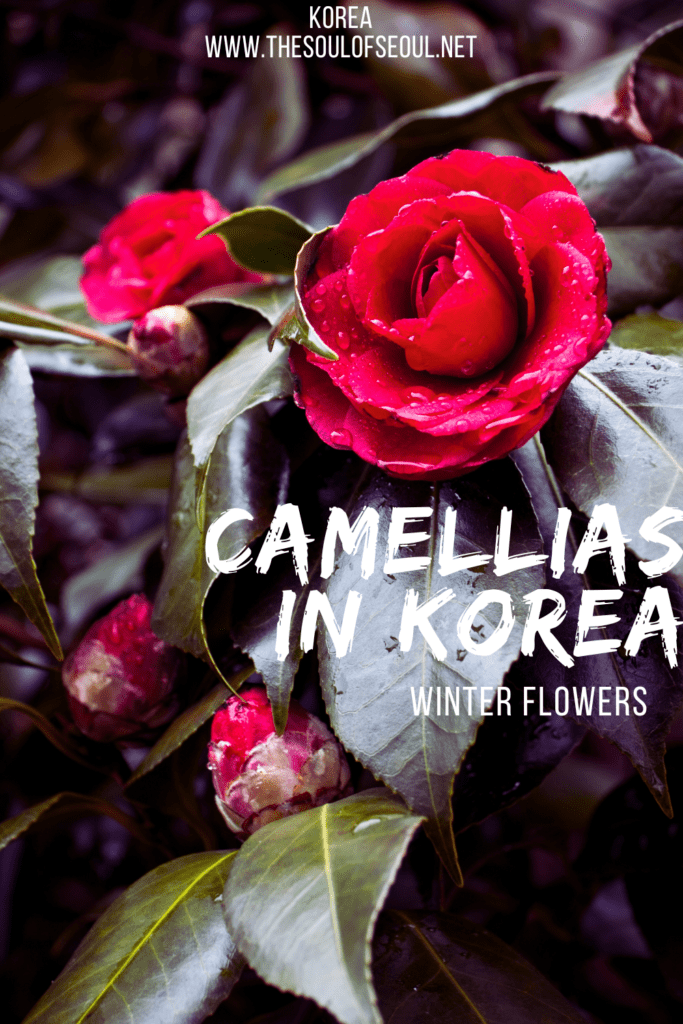A Guide To Korea’s Winter Bloom: Where To See Camellias
Last Updated on January 3, 2024
When you picture winter in Korea, you probably picture snowy mountains, ski resorts, and steamy street food stalls. That said, did you know there are flowers that bloom in the winter in Korea? While there can be plenty of snow and plenty of cozy indoor spots to hang, if you head to the southern provinces of Korea, you’ll be able to find flowers! Yes, flowers in the winter! Camellias (동백꽃) bring a splash of color to the winter canvas, offering a delightful experience for visitors and locals alike.
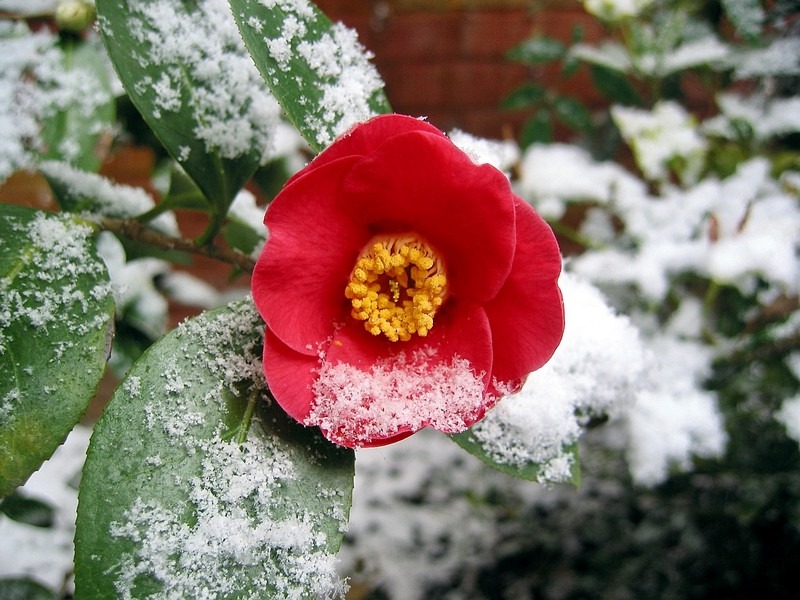
As the cold sets in, a natural wonder unfolds across the southern regions of Korea that are the pick-me-up you might need if winter is just a bit too much to bare.
- What to know about camellias in Korea
- Where to see camellia flowers in Korea
- Camellia tea (동백(꽃차)냉차)
(This post contains affiliate links, which means I receive a certain percentage of a sale if you purchase after clicking at no cost to you. Thank you for your support.)
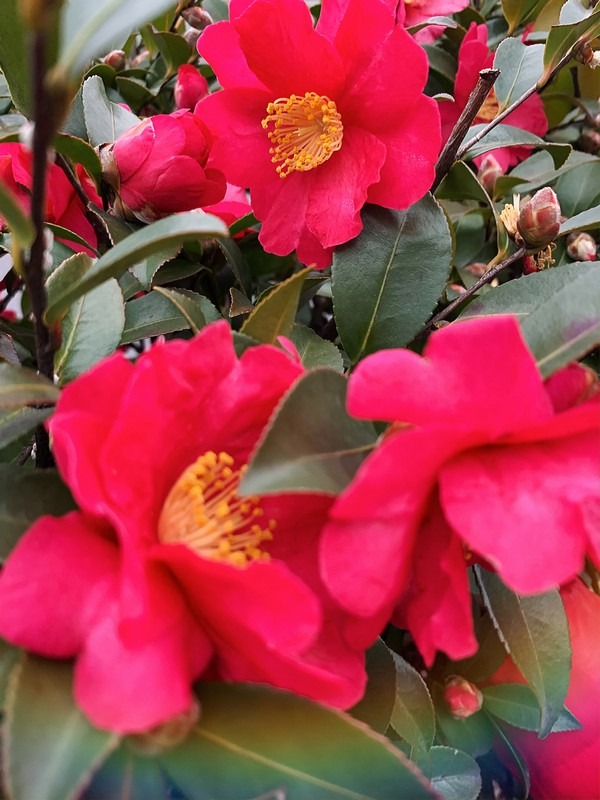

What to know about camellias in Korea
Native to Korea, camellia flowers bloom from November to March in the southern regions of South Korea. That said, camellia flowers are sensitive to weather changes and are being used as an indicator to significant weather changes on the peninsula. Camellia flowers are beginning to grow in more inland areas of Korea signifying climate change in the country.
Did you know: During the Joseon Dynasty, women used to put camellia oil on their hair and comb it to style it. The oil added shine and kept it neat.
Whether you’re a flower enthusiast or just seeking a unique winter experience, South Korea’s camellia blooms are a delightful spectacle.
Where to see camellia flowers in Korea
Each location offers a unique blend of natural beauty and cultural charm, making your winter visit to Korea a colorful and memorable journey. So, pack your cameras and warm clothes, and embark on a floral adventure across Korea’s winter wonderland!


Jisimdo Island (지심도)
Off the coast of Geoje Island (거재도) lies Jisimdo Island, a heart-shaped oasis blanketed with camellia flowers. Approximately 70% of this island, also known as Camellia Island (동백섬), is covered with these blooms, making it a stunning winter destination. The camellia season here starts in December and stretches till mid-April, with the flowers reaching their peak beauty between March and April. The island’s camellia trees are not only abundant but also ancient, with some aged between 400 to 1000 years.
- Address: 31-2 Jisimdo-gil, Geoje-si, Gyeongsangnam-do (경상남도 거제시 일운면 지심도길 31-2)
- Directions: Accessible via a 15-minute ferry ride from Geoje Island’s Jangseungpohang Port, Jisimdo offers a picturesque 2-hour walk along no-car roads, perfect for a tranquil winter stroll.
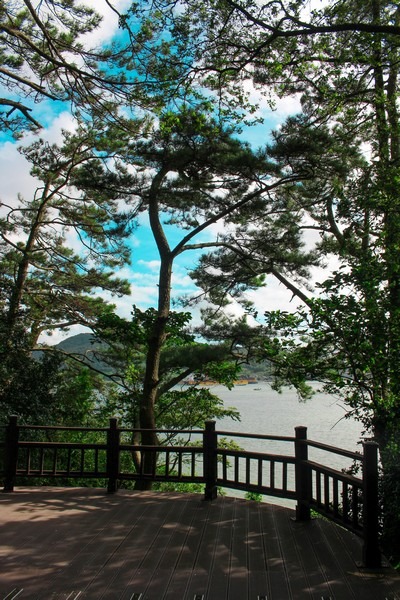
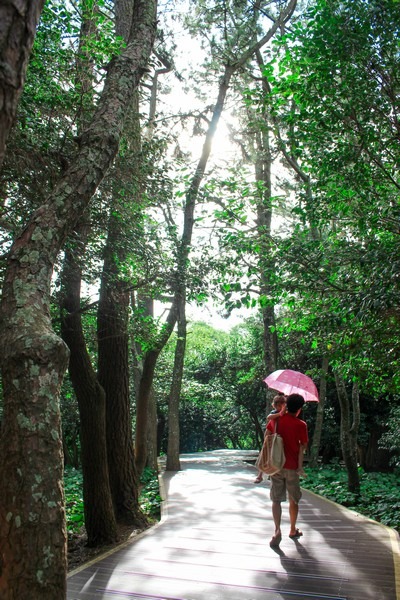
Yeosu Odong Island (여수 오동도)
Yeosu makes for a fantastic trip away with a lot to see right in walking distance of each other. One of the highlights of the area is Odong Island which has camellias that have a later bloom, typically from January to March. The island, accessible via a pedestrian-friendly land bridge or a leisurely electric train ride, is a blend of natural beauty and artistic charm. Trails leading to the Odongdo Lighthouse offer breathtaking ocean views, complemented by the vibrant camellias.
- Address: 222 Odongdo-ro, Yeosu-si, Jeollanam-do (전라남도 여수시 오동도로 222)
- Directions:
Sacheon Nosan Park (사천시 노산공원)
For those seeking a quieter spot, Nosan Park in Sacheon, Gyeongsangnam-do, is a less-known yet charming destination. The park features an array of camellia trees, more modest in size compared to those in Jeju, but equally beautiful. A leisurely walk in the park reveals hidden camellia treasures, best enjoyed in the warmth of midday.
- Address: 27 Bakjaesam-gil, Sacheon-si, Gyeongsangnam-do (경남 사천시 박재삼길 27)
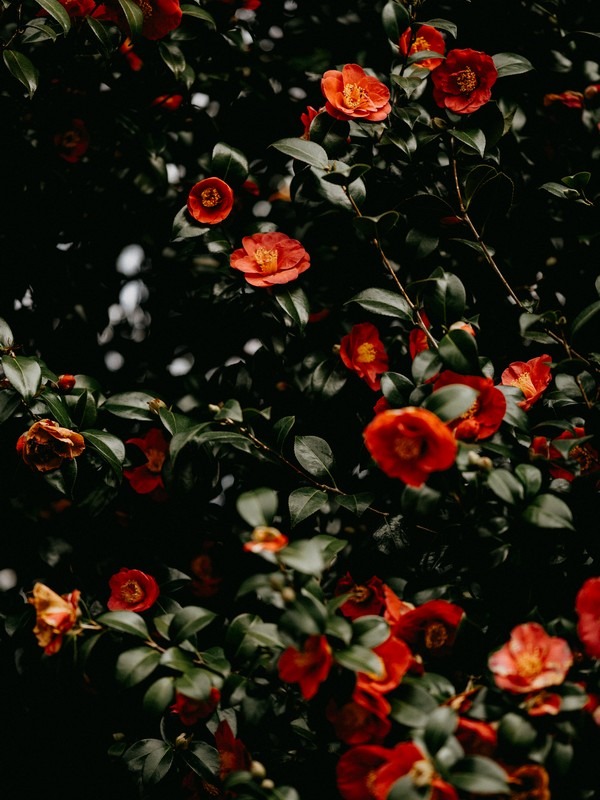
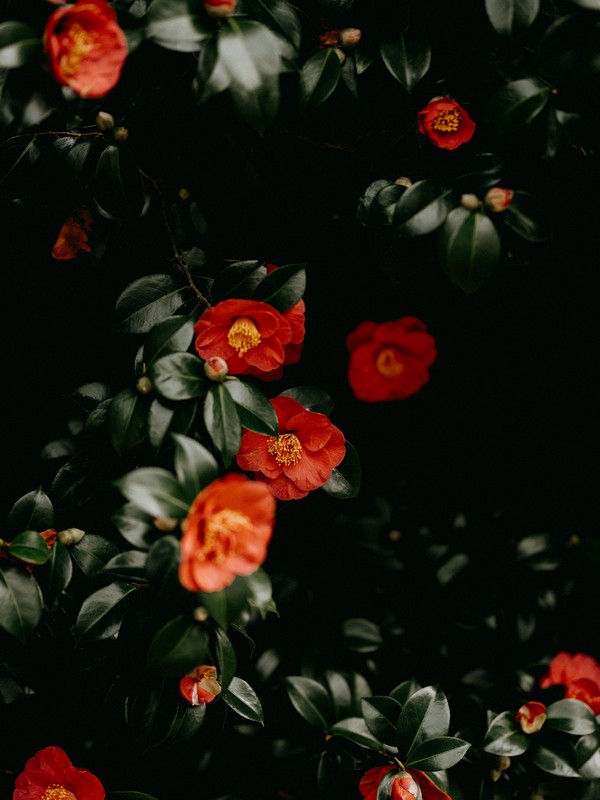
Jeju Camellia Arboretum (동백수목원)
Jeju Island, often thought of as a summer destination, transforms into a camellia heaven during winter and there are a number of great places to see the red blooming beaties. The Jeju Camellia Arboretum has a vibrant maze of cottony candy shaped trees that flower with camellia blooms with peak months in January and February. The dense plantation creates a unique experience, with the tall camellia trees forming a canopy that filters the sunlight, offering a magical walk through nature.
- Address: 288 Taewi-ro, Seogwipo-si, Jeju-do (제주특별자치도 서귀포시 남원읍 태위로 288)
- Hours: Every day: 9:30am ~ 5:30pm
Jeju Camellia Hill (카멜리아힐)
See not only Korean camellia flowers, but this garden showcases camellias from around the world in different themed gardens including the European camellia forest, baby camellia forest, secret camellia forest path, and inside a green house. This is one of the most Instagrammable places to see camellia flowers.
- Address: 166 Byeongak-ro, Seogwipo-si, Jeju (제주특별시 서귀포시 안덕면 병악로 166)
- Hours: December – February: 8:30am ~ 6:00pm; March – May & September – November: 8:30am ~ 6:30pm; June – August: 8:30am ~ 7:00pm
- Buy Tickets Online: If you book in advance through kkday you can get discounted tickets.
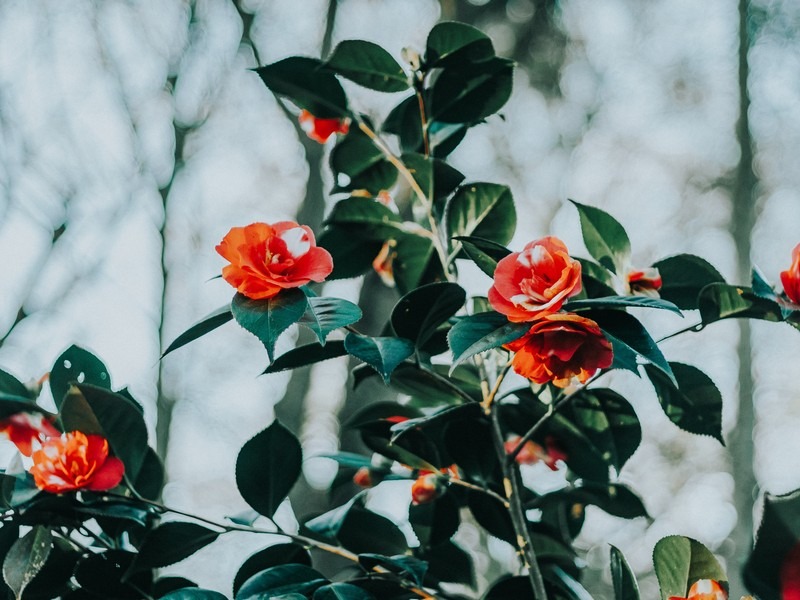
Jangsado Sea Park (장사도 해상공원)
A gem featured in the beloved Korean drama “My Love from the Star”, the island is a treasure trove of natural beauty, with about 100,000 trees, including an array of camellias and silver magnolias. Its rich biodiversity includes the enchanting fairy pitta and white-eye birds, both adding to the island’s allure.
The island’s name, originally “Jamsado” for its silkworm-like shape, echoes its history and transformation over time. In summer, it’s adorned with a blanket of vibrant hydrangeas, while winter brings the majestic bloom of camellias. Committed to preserving its natural beauty, urban development on the island is thoughtfully limited, ensuring that its pristine charm remains undisturbed.
Scattered across the island are various sculptures and artistic installations, enhancing the visual experience. The island is a place where nature, history, art, and culture intertwine to create an unforgettable journey.
- Address: 95 Jangsado-gil, Tongyeong-si, Gyeongsangnam-do (경상남도 통영시 한산면 장사도길 95)
- Hours: April – September: 8:00am ~ 7:00pm; October – March: 8:30am ~ 5:00pm
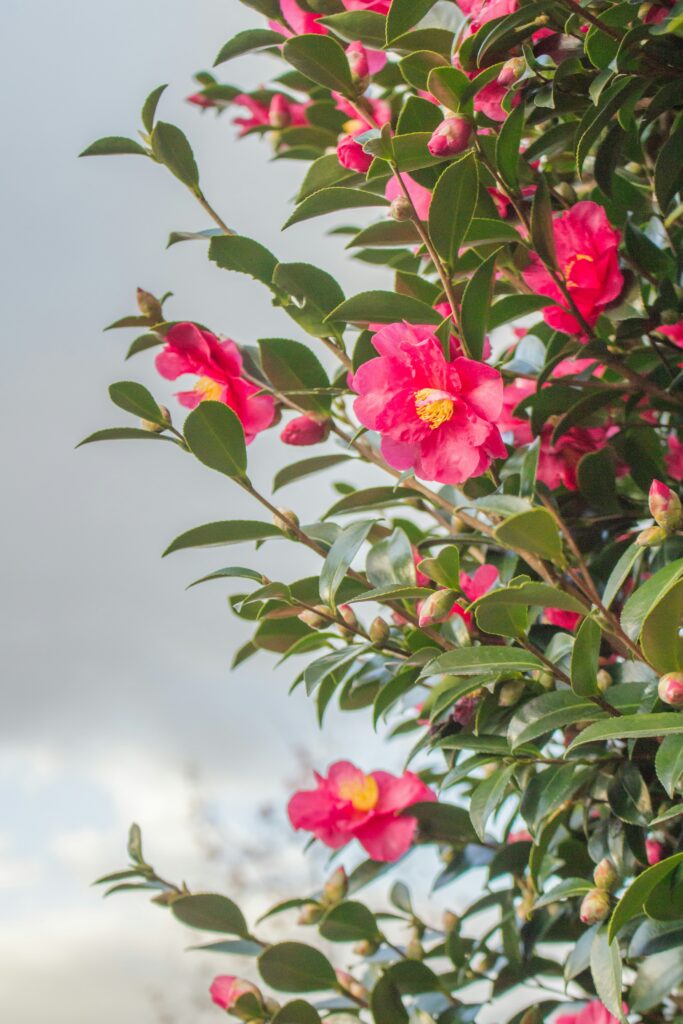
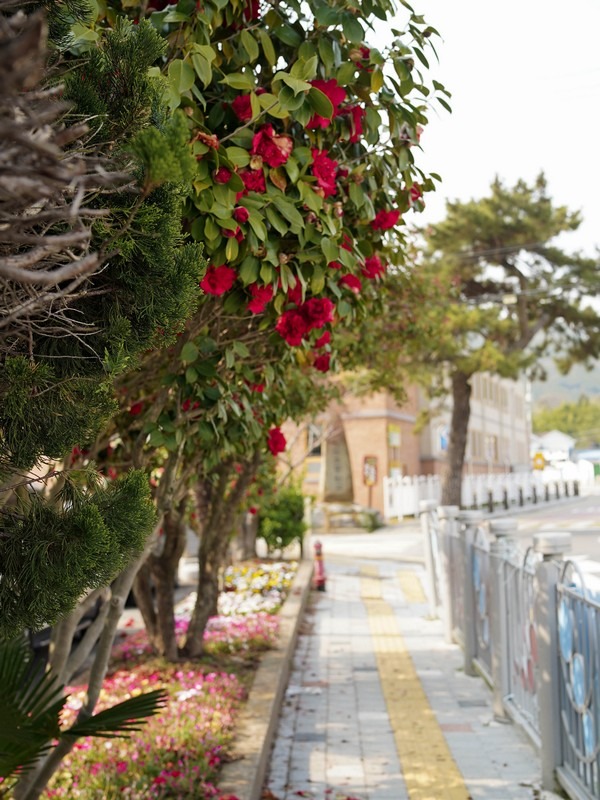
Busan Haeundae Dongbaekseom Island (해운대 동백섬)
Dongbaekseom Island in Busan, named for its abundant camellias, offers a serene escape with its dense pine forest and panoramic ocean views. The island used to be, well an actual island, but is now connected to the mainland. Located near Haeundae Beach, it’s a convenient stop for travelers in Busan.
- Address: 67 Dongbaek-ro, Haeundae-gu, Busan (부산특별시 해운대구 동백로 67)
Gochang Seonunsa Temple (선운사 (고창))
Seonunsa Temple in Gochang not only holds historical significance but is also home to a camellia forest. The temple was originally built in 577, the 24th year of King Wideok of the Baekje Kingdom and it is the second head temple of the Jogye Order in Jeollabuk-do. Originally built with 89 hermitages, today there are only 4 hermitages left, but it’s beautifully set against the Forest of Common Camellias.
- Address: 250 Seonunsa-ro, Gochang-gun, Jeollabuk-do (전라북도 고창군 아산면 선운사로 250)
Seocheon Maryang-ri Camellia Forest (서천 마량리 동백나무 숲)
One of Seocheon’s eight picturesque vistas and a revered Natural Monument, this forest is home to nearly 500-year-old camellia trees. Perched atop a hill within this lush forest stands the Dongbaekjeong Pavilion, a serene vantage point offering breathtaking panoramic views. Gaze out at the tranquil Oryeokdo Island set against the backdrop of the azure sea, and indulge in the spectacle of stunning sunsets, making it a photographer’s paradise.
While the western side of the forest whispers tales of the past with its sparse trees, the eastern side is a thriving haven, boasting over 70 camellia trees. Unique to this forest is the intriguing growth of these trees. Shaped by the relentless sea breeze, they grow at a fascinating slant and reach only about 2 meters in height, unlike their typical 7-meter stature.
- Address: 103 Seoin-ro 235beon-gil, Seocheon-gun, Chungcheongnam-do (충청남도 서천군 서면 서인로235번길 103)
- Hours: Every day: Summer Hours: 9:00am ~ 6:00pm; Winter Hours: 9:00am ~ 5:00pm
- Closed on January 1, Lunar New Year Day and Korean Thanksgiving Day
- Admission: Adults: W1,000; Teenagers: W700, Children: W500
Camellia tea (동백(꽃차)냉차)
Camellia flowers, the same family as tea trees used for green tea, have a long history in Korean herbal practices for their health benefits. These flowers are known for their diuretic properties and ability to enhance blood circulation. The process of making Camellia Tea is a traditional art, involving careful timing and preparation.
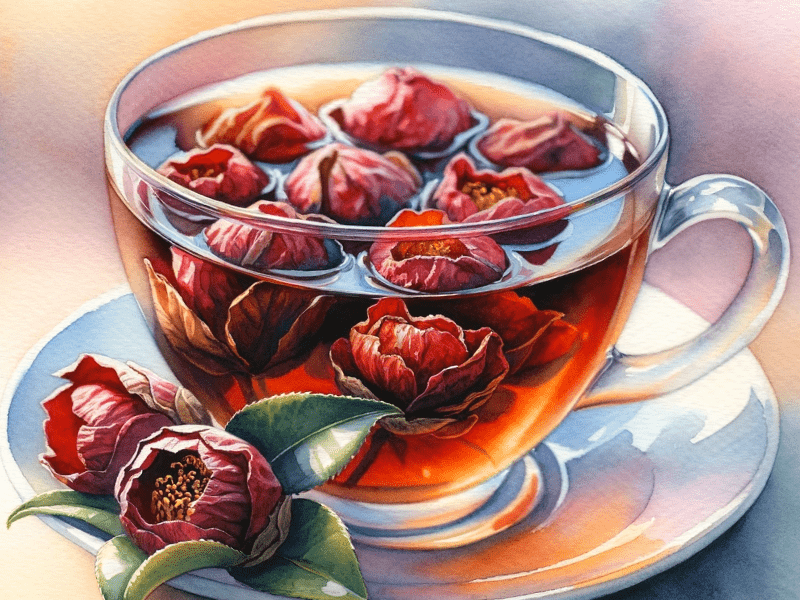
To create this unique tea, the buds are harvested just before the camellia flowers reach full bloom. Depending on their type, the buds are then processed differently: double blooms are dried, while single blooms are preserved in honey. The drying process for the former takes about a week. Once dried, these blooms are stored in a glass jar, submerged in honey until completely covered. This concoction is then refrigerated for a fortnight, allowing the flavors and properties of the camellia to infuse into the honey.
When it’s time to enjoy a cup, two to three camellia buds are added to hot water at approximately 90°C. The result is a warm, aromatic tea that can also be savored chilled, offering a refreshing alternative. This traditional Korean Camellia Tea is not only a beverage but a connection to the rich herbal legacy of the region.
Did you like this post? Pin iT!

